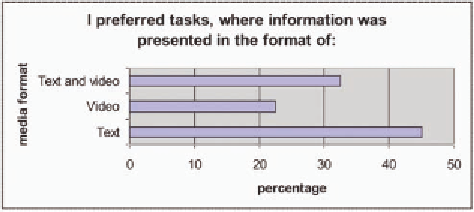Information Technology Reference
In-Depth Information
Table 7. Summary of findings related to content
Issue
Finding
Dynamic content
Mobile content was expected to be dynamic; users were disappointed to receive static content.
Location aware content
Users expected direct access to localized content.
Combining digital with the physical
Digital content that integrated with the physical experience was perceived most interesting.
over other content formats in the Amazing NFC
trial (see Figure 10). Pupils also reported that
they occasionally became frustrated with the long
download times:
anybody, it might not be reasonable to assume all
service providers even care to maintain tags after
distributing them.
In the Amazing NFC trial, the tags were made
available only in selected places, so the pupils
did not run into or pay attention towards tags that
were not specifically targeted for their use, and
they reported no problems with non-functional
tags. Maintaining the integrity and functional-
ity of a specific set of tags is of course easier,
than maintaining a ubiquitous assembly of tags
distributed around the urban environment. Also,
reporting malfunctioning tags could be easily
done by calling the teacher in charge during the
Amazing NFC lesson, whereas error reporting
would be considerably more difficult for generic
Mobile Internet services available through infor-
mation tags. However, no problems in the technical
functionality of the tags were observed during the
Amazing NFC trials.
Table 8 summarizes findings related to techni-
cal problems.
“You had to wait for a long time for a web site to
download.” (translated by the authors)
In the information tag trial, tags were ubiqui-
tous and could be placed virtually anywhere in a
public space. Some of the tags that the users found
were visible and available for touching but not
operational because they were broken or set up to
work only with certain devices for specific users.
The users found these situations very annoying.
They expected that they would get some response
from all the tags that were available for touching,
and when that did not happen, they were irritated.
As tags are cheap and easy to attach almost
anywhere, there is a danger of “tag litter” that can
destroy the user experience and especially trust
towards tags in general. As tags are not continu-
ously connected to a network, it is difficult for
service providers to notice when a tag becomes
inoperable. As tags can be distributed by virtually
Figure 10. Preferred media formats of Amazing NFC participants according to the web survey (n=81)


















Search WWH ::

Custom Search